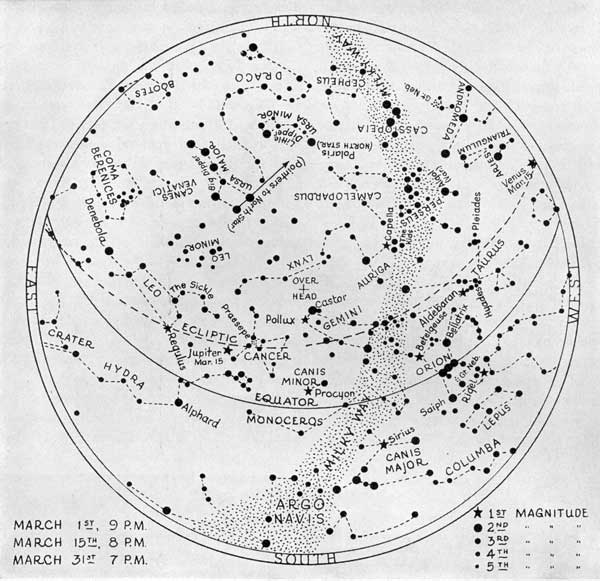March and Its Stellar Performers
Mercury and the Zodiacal Light Play Title Roles This Month
By ISABEL M. LEWIS
Nature Magazine, March 1932
Page 1 | Page 2
The springtime, during which the, ecliptic rises most sharply from the horizon, is the best period of the year for searching out the planet Mercury and also for seeing the Zodiacal Light, that faint nebulous glow which is about equal to the Milky Way in brightness and which stretches upward from the horizon at the point where the sun has set.
This spectacle appears in the form of a cone or wedge with its base on the horizon and its blunt apex along the ecliptic at a distance above the horizon which varies with atmospheric conditions and visibility. Only when the air is very clear may one view this interesting phenomenon.
In the tropics, particularly at sea, the Zodiacal Light is conspicuous and beautiful on many nights and often extends as a luminous band from the western to the eastern horizon along the ecliptic; but in the temperate zones it assumes a triangular appearance, and is quite faint and hazy.
The Zodiacal Light is caused by the reflection of sunlight from fine particles of cosmic dust or gas molecules that surround the sun within the orbit of the earth. An attendant phenomenon far more difficult to observe is the Gegenschein, or Counterglow, which is the reflection of sunlight from a condensation of such particles at a distance of about a million miles beyond the earth and directly opposite to the sun. Here, under the combined attraction of sun and moon, the particles are drawn into a whirlpool of motion and the result is a faint, luminous patch about ten degrees in diameter. Very few have ever seen the Gegenschein, as it can be observed only on nights of exceptionally fine visibility.

Mercury is the least observed of the five bright planets and one always experiences a thrill of pleasure when he succeeds in finding this brilliant little planer. It always seems to be playing hide and seek with us in the evening twilight and never wanders farther than twenty-eight degrees from the sun. Record of observations of Mercury date back as far as 264 B.C., bur at first it was not recognized as the same planet when seen on opposite sides of the sun. It was called Apollo when visible in the eastern sky before sunrise and Mercury when visible in the west after sunset.
Mercury is exceptional among the planets in many ways. It is the smallest of all of them, being a little more than three thousand miles in diameter. Jupiter and Saturn both have moons equal to or greater than Mercury in size. It is the nearest to the sun and the swiftest in its motion. Its year is only eighty-eight days long and its average distance from the sun about 36 million miles. Its orbit is the most flattened of all the planetary orbits and is inclined at the highest angle to the ecliptic.
This planet is a world without an atmosphere, and it is practically certain that it always keeps the same face toward the sun. One side, therefore, is scorched perpetually by a heat intense enough to melt lead while the opposite side, on which the sun never shines, is doomed to frigid blackness in which the temperature must" be nearly at the absolute zero of space. Its density is about equal to that of the moon and so is its reflecting power. It is probably a rocky, barren little world very much like our satellite.
So much for what we know about the brilliant little star-like object that you may be able to pick up in the evening twilight from about the sixteenth to the twenty-eighth of March, a little north of west and not far above the horizon. Only its sparkling brilliancy makes it visible when in the twilight and so near the sun. Mercury will reach its greatest eastern elongation, that is, its greatest distance east of the sun, on March 23 at almost exactly seven 0' clock in the evening, Eastern Time. Its distance from the sun at that time will be just eighteen degrees and forty minutes. It will appear in the telescope as a beautiful little half moon, for, like the moon, Mercury and Venus exhibit phases, since their orbits lie between that of the earth and the sun. Before elongation it will be like the gibbous moon in appearance and a few days later will be noticeably crescent in shape. It is generally visible for about a week before and after the date of elongation. During this time it will change very considerably in brightness.
Page 1 | Page 2
 Printer-friendly version
Printer-friendly version
